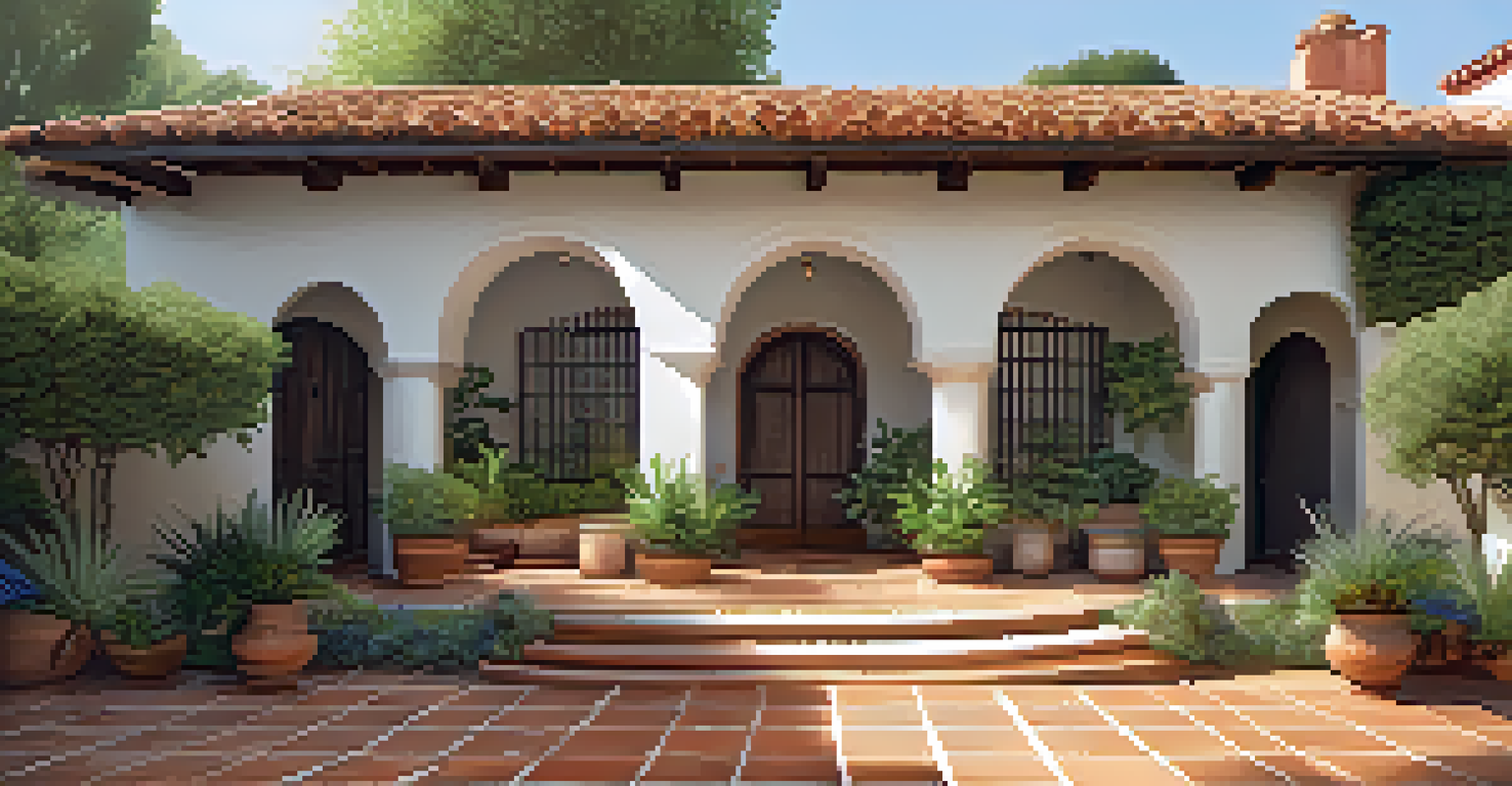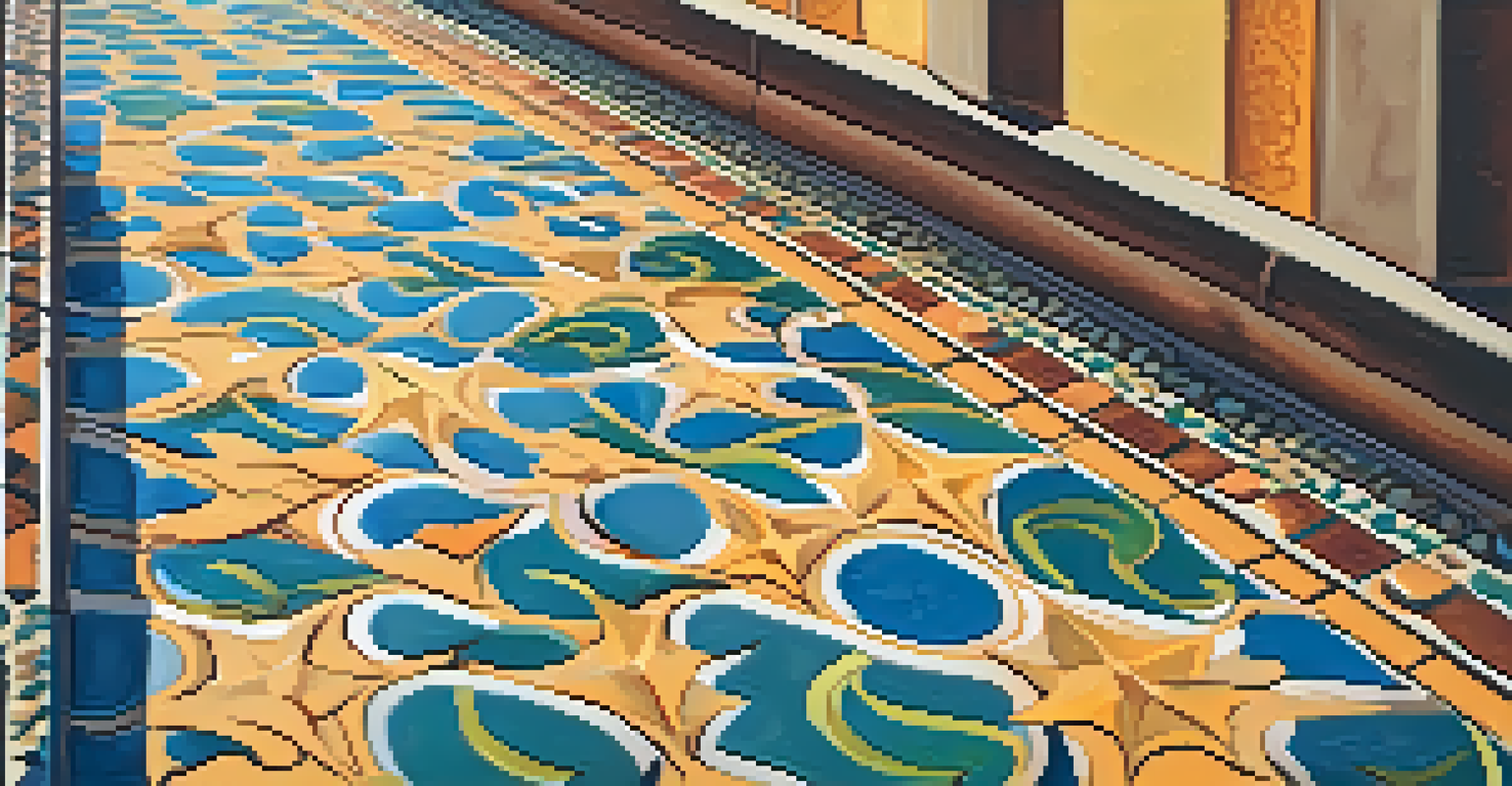The Influence of Spanish Revival Style in Phoenix Architecture

An Overview of Spanish Revival Architecture
Spanish Revival architecture, rooted in the early 20th century, draws inspiration from the colonial buildings of Spain and Latin America. This style is characterized by its rich textures, vibrant colors, and intricate detailing, which create an inviting and warm aesthetic. In Phoenix, the influence of Spanish Revival can be seen in many residential and commercial buildings, contributing to the city's unique architectural identity.
Architecture is the learned game, correct and magnificent, of forms assembled in the light.
This architectural style emphasizes a connection to the environment, often incorporating natural materials like stucco, tile, and wood. The use of arches, wrought iron, and decorative tiles further enhances its charm. As Phoenix developed in the 1920s and 1930s, the Spanish Revival style became a popular choice for those seeking to embrace the cultural richness and history it represents.
The appeal of Spanish Revival architecture goes beyond mere aesthetics; it evokes a sense of nostalgia and romance. For many, these buildings tell a story of cultural heritage, blending the influences of indigenous peoples and Spanish settlers, and creating a rich tapestry of architectural expressions.
Key Features of Spanish Revival Style
Spanish Revival architecture is easily recognizable due to its distinctive features. Elements such as red-tiled roofs, stucco walls, and arched doorways create a cohesive look that is both elegant and rustic. These characteristics not only provide visual interest but also serve practical purposes, such as withstanding the harsh Arizona climate.

Another defining feature is the use of decorative tiles, often in vibrant colors and intricate patterns. These tiles can be found in walkways, fountains, and as accents on buildings, adding a splash of personality and charm. The incorporation of wrought iron details, especially in railings and window grilles, further accentuates the style's artisanal quality.
Spanish Revival's Unique Aesthetic
Spanish Revival architecture features rich textures, vibrant colors, and intricate details that create a warm and inviting atmosphere.
Additionally, many Spanish Revival buildings include courtyards and gardens that reflect a seamless transition between indoor and outdoor spaces. This design philosophy promotes relaxation and socialization, making these homes and buildings perfect for the warm Phoenix climate.
Historical Context of Spanish Revival in Phoenix
The Spanish Revival style gained prominence in Phoenix during the early 20th century, coinciding with the city's rapid growth. As more people flocked to the area for its warm climate and economic opportunities, architects sought to create a distinct identity for the city. The Spanish Revival style emerged as a favored choice, reflecting both nostalgia for the past and a desire for a unique architectural language.
A building has two lives. The one it imagines and the one it lives. The longer it lives, the more of its lives it loses.
In the 1920s, the trend was fueled by the burgeoning Southwestern tourism industry, which attracted visitors enchanted by the region's rich cultural history. Architects like Ross and Mary Lee, along with many others, began to design homes and public buildings that embraced this style, resulting in a captivating architectural landscape that still resonates today.
As Phoenix evolved, the Spanish Revival aesthetic continued to influence new developments, ensuring its place in the city's architectural narrative. The style not only reflects the historical context of the area but also serves as a testament to its evolving identity.
Prominent Examples in Phoenix
Phoenix is home to numerous examples of Spanish Revival architecture, with some of the most notable found in established neighborhoods like Coronado and Encanto. These areas showcase stunning homes adorned with the hallmarks of the style, creating a cohesive visual experience for residents and visitors alike. The architectural charm of these neighborhoods is often a driving factor for homebuyers seeking character and history.
One prominent example is the iconic Wrigley Mansion, originally built in 1929. This grand estate features stunning Spanish Revival elements, including elaborate tile work and a picturesque courtyard. Today, it serves as a restaurant and event venue, allowing visitors to appreciate its architectural beauty while enjoying the rich history it represents.
Cultural Heritage Reflected in Design
This architectural style embodies a blend of Native American, Spanish, and Mexican influences, shaping Phoenix's cultural identity.
Another remarkable structure is the Arizona Biltmore Hotel, known for its luxurious accommodations and distinctive design. Completed in 1929, the hotel combines Spanish Revival with elements of Frank Lloyd Wright's Prairie School style, creating a unique architectural masterpiece that continues to attract guests from around the world.
The Role of Cultural Identity in Spanish Revival Architecture
Spanish Revival architecture in Phoenix reflects a broader cultural identity that celebrates the region's diverse heritage. The blend of Native American, Spanish, and Mexican influences creates a rich tapestry that is uniquely Southwestern. This architectural style serves as a visual representation of the area's history and cultural evolution, fostering a sense of community and belonging.
As the city continues to grow and evolve, preserving these architectural gems becomes crucial in maintaining a connection to the past. The Spanish Revival style serves as a reminder of the stories and traditions that shape Phoenix's identity, making it an essential part of the city's character.
Additionally, the continued popularity of this style speaks to a collective appreciation for craftsmanship and attention to detail. Homebuyers and builders alike are drawn to the authenticity and warmth that Spanish Revival architecture offers, ensuring its relevance in modern Phoenix.
Modern Interpretations of Spanish Revival Style
In recent years, architects and builders in Phoenix have embraced modern interpretations of Spanish Revival style. By incorporating contemporary design elements and sustainable practices, they are able to create homes that honor the traditional aesthetic while meeting the needs of today's homeowners. This fusion of old and new ensures that the Spanish Revival style remains relevant in a rapidly changing architectural landscape.
For instance, many new constructions utilize energy-efficient materials and technologies while still maintaining the characteristic stucco finishes and tile roofs. These modern adaptations not only respect the original style but also promote sustainability, making them appealing to environmentally conscious buyers.
Modern Adaptations Preserve Tradition
Contemporary architects are reinterpreting Spanish Revival elements with sustainable practices, ensuring its relevance in today's housing market.
Moreover, the resurgence of interest in Spanish Revival style has sparked a revival of craftsmanship, as artisans and builders seek to recreate the intricate details that define this architectural genre. This dedication to quality and authenticity ensures that the spirit of Spanish Revival architecture continues to thrive in Phoenix.
Preserving the Legacy of Spanish Revival Architecture
As Phoenix continues to grow, the preservation of Spanish Revival architecture becomes increasingly important. Local preservation societies and community organizations work tirelessly to raise awareness about the value of these historic buildings. Their efforts aim to protect the unique character of neighborhoods and ensure that future developments honor the architectural heritage of the area.
Community events and educational programs often highlight the significance of Spanish Revival style, fostering appreciation among residents and visitors alike. By engaging the public in discussions about the importance of architecture and history, these organizations help cultivate a sense of pride in the city’s cultural identity.

Ultimately, the preservation of Spanish Revival architecture is not just about maintaining structures; it is about safeguarding the stories and traditions that define Phoenix. As these buildings continue to stand the test of time, they serve as a reminder of the rich history and diverse influences that have shaped the city into what it is today.